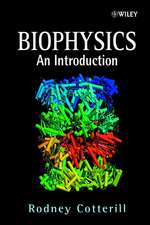Physical and Biological Bases of Life Stability: Man, Biota, Environment
Autor Victor G. Gorshkoven Limba Engleză Paperback – 16 dec 2011
Preț: 391.61 lei
Nou
Puncte Express: 587
Preț estimativ în valută:
74.93€ • 78.45$ • 62.00£
74.93€ • 78.45$ • 62.00£
Carte tipărită la comandă
Livrare economică 07-21 aprilie
Preluare comenzi: 021 569.72.76
Specificații
ISBN-13: 9783642850035
ISBN-10: 3642850030
Pagini: 356
Ilustrații: XI, 340 p.
Dimensiuni: 155 x 235 x 19 mm
Greutate: 0.5 kg
Ediția:Softcover reprint of the original 1st ed. 1995
Editura: Springer Berlin, Heidelberg
Colecția Springer
Locul publicării:Berlin, Heidelberg, Germany
ISBN-10: 3642850030
Pagini: 356
Ilustrații: XI, 340 p.
Dimensiuni: 155 x 235 x 19 mm
Greutate: 0.5 kg
Ediția:Softcover reprint of the original 1st ed. 1995
Editura: Springer Berlin, Heidelberg
Colecția Springer
Locul publicării:Berlin, Heidelberg, Germany
Public țintă
ResearchCuprins
1. Ecological Stability.- 1.1 Introduction.- 1.2 Biological Regulation of the Environment.- 1.3 Means of Biological Regulation of the Environment.- 1.4 The Action of the Le Chatelier Principle in the Biosphere.- 1.5 Violations of the Le Chatelier Principle in the Contemporary Biosphere.- 1.6 Biosphere as a “Free Market”.- 1.7 Biospheric Communities.- 1.8 Evolution Rates.- 1.9 Progress.- 1.10 Conservation of the Biosphere.- 1.11 A Transition to the Noosphere?.- 2. Solar Energy and Ordered Processes in Inanimate Nature.- 2.1 Decay of Ordered States.- 2.2 Solar Energy.- 2.3 The Physical States of Dynamic Equilibrium.- 2.4 The Stability of Physical States.- 2.5 Physical Self-Organization.- 2.6 The Measurable Variables: Dimensions and Mutual Correlations.- 2.7 Thermal Stability of Climate.- 2.8 Correlation Distances and Information.- 3. Stability of Life Organization.- 3.1 Biological Stability.- 3.2 Differences Between Biological and Physical Stability.- 3.3 The Quantum Nature of Life.- 3.4 The Nature of Genome Decay.- 3.5 Population: a Stationary State.- 3.6 Normal Genotypes and the Normal Genome.- 3.7 Neutral Mutations.- 3.8 Normal, Decay, and Adaptive Polymorphism in a Population.- 3.9 Stability of the Biological Species.- 3.10 Genetic Recombinations.- 3.11 Sexual Dimorphism and Regulation of Birth Rate of Decay Individuals.- 3.12 Diploid and Polyploid Genomes.- 3.13 Heterozygosity.- 3.14 Stability of the Diploid Genome.- 3.15 The Evolution of Species.- 3.16 Evolution of Prokaryotes and Eukaryotes.- 3.17 The Rate of Evolution.- 3.18 Is There Extraterrestrial Life in the Universe?.- 3.19 Biological Stability and Neo-Darwinism.- 4. Stability of the Biosphere’s Organization.- 4.1 Limitations to Expansion and Evolution of Species.- 4.2 Closed Matter Cycles in theBiosphere.- 4.3 Biological Cycles.- 4.4 The Le Chatelier Principle in Natural Biota.- 4.5 Biospheric Communities.- 4.6 Biological Regulation of Matter Cycles.- 4.7 Biological Stability and Limiting Nutrients.- 4.8 Productivity and Immigration in the Community.- 4.9 The Biological Pump of Atmospheric Carbon.- 4.10 Atmospheric Concentration of CO2 and New Production by the Ocean.- 4.11 Changing Production of Dissolved Organic Matter in the Ocean.- 4.12 Changes in the Global Cycle of Carbon.- 4.13 The Water Cycle.- 4.14 Competitively Interacting Communities and the Gaia Hypothesis.- 5. The Energetics of Biota.- 5.1 Metabolic Power of the Individual.- 5.2 Body Size Limits.- 5.3 Energetics and Body Size of Photosynthesizing Plants.- 5.4 Fluctuations in Synthesis and Destruction of Organic Matter.- 5.5 Immotile and Locomotive Organisms.- 5.6 Distribution of Consumption by Heterotrophs According to Their Body Size.- 5.7 Daily Average Travelling Distance.- 5.8 The Maximum Speed of Movement for Animals.- 5.9 Maximum Permissible Share of Biomass Consumed by Mobile Animals.- 5.10 Settled and Nomadic Lifestyles for Locomotive Animals.- 5.11 Carnivores.- 5.12 Diffusion of Excreta.- 5.13 Detailed Distribution of Destructiveness with Body Size.- 5.14 Brief Conclusions.- 6. The Ecology of Man.- 6.1 Behavioral Strategy of Mobile Animals.- 6.2 Herd Animals.- 6.3 Territorial Animals.- 6.4 Genetic and Cultural Heritage.- 6.5 The Ecological Niches of Man.- 6.6 Climatological, Biological, and Ecological Limits of Energy Consumption by Man.- 6.7 Science and Religion.- 7. Conclusion.- Appendix A Details of Calculations in Sect. 4.11.- Appendix B Details of Calculations in Sect. 4.12.- Appendix C Details of Calculations of the Results in Fig. 6.2.- Appendix D List of Frequently Used Symbols.














